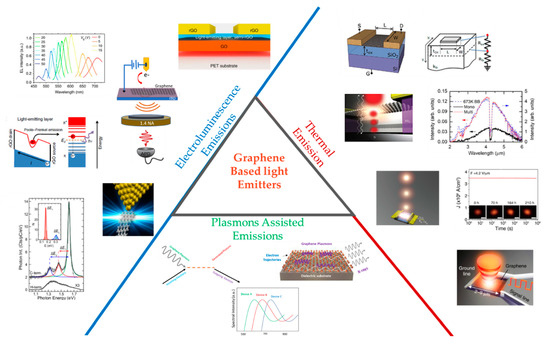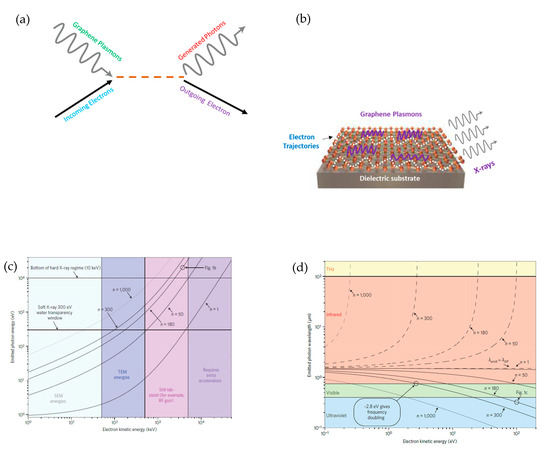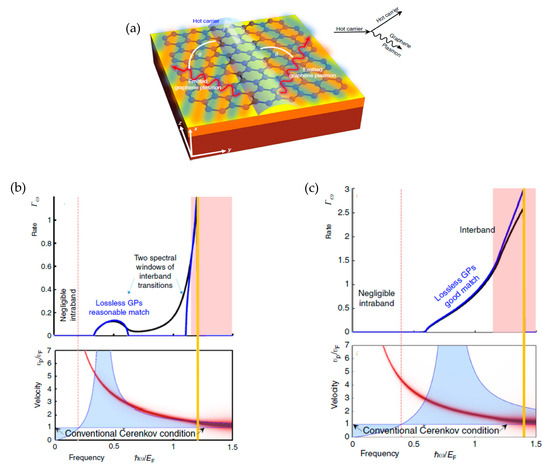Light emissions from graphene-based active materials can provide a leading platform for the development of two dimensional (2-D), flexible, thin, and robust light-emitting sources. In this arsticleudy, we present a comprehensive review of recent developments in graphene-based light-emitting devices. Light emissions from graphene-based devices have been evaluated with different aspects, such as thermal emission, electroluminescence, and plasmons assisted emission. Theoretical investigations, along with experimental demonstration in the development of graphene-based light-emitting devices. Moreover, the graphene-based light-emitting devices are also addressed from the perspective of future applications, such as optical modulators, optical interconnects, and optical sensing. Finally, this review provides a comprehensive discussion on current technological issues and challenges related to the potential applications of emerging graphene-based light-emitting devices.
- Nanotechnology
- Nanomaterials
- Nanophotonics
1. Introduction
Graphene is a single layer honeycomb structure of carbon lattice [1] with many interesting behavior and characteristics [2]. It is considered the most promising material for engineering design due to its extraordinary electrical, mechanical, and chemical properties [3,4,5]. Since 2004, the exfoliation of single-layer graphene [6] has been investigated and explored in every field of science. Additionally, an exponential increment in terms of publication numbers was perceived with substantial results [7,8]. Graphene as an attractive material has been extensively researched in many fields of electrical and electronic engineering, such as touch screens, light detectors, transparent conductors, photovoltaic cells, and energy systems [9,10,11]. Besides, the optoelectronic properties of graphene-based materials are being highly investigated for the application of optoelectronic devices [12]. The direct bandgap opening [13,14,15], strong light-matter interaction [16], photoluminescence [17], electrons field emission [18], and the evidence of emission radiation from graphene make it a promising material for the future generation of optical devices to produce a thin, flexible, and lightweight optoelectronics device [19].
In the context of light-emitting diode (LEDs), the existing LEDs technology is considered quite mature, even at the consumer end. LEDs have already been applied in several fields, including signage, display backlight, general illumination, and communications [20,21]. LEDs have high-performance characteristics, such as low power consumption, high efficiency, high-speed response, low operating voltage (< 4 V), current (< 700 mA) characteristics, and small outline dimensions (< 10 mm to 10 mm) [22]. Solid-state light-emitting devices (LEDs) are classified into two main streams: organic (OLEDs) and inorganic LEDs. Conventional inorganic LEDs are composed of brittle or hard powdery material, i.e., silicon, phosphor, lens, and glass. Many key research areas in LED designing, such as quantum efficiency of the active region, current-flow design, resistive losses, electrostatic discharge stability, and optimization of luminous flux per LED package, need improvements [23]. However, flexible and transparent light-emitting devices with a small footprint are of key focus. The development and manufacturing of OLEDs carried out in recent years are still facing drawbacks [24]; for example, the panel fabrication at high-temperature conditions and to incorporate flexible substrate PET (polyethylene terephthalate). ITO-based electrodes are too stiff for the development of flexible OLEDs [25]. The graphene is also considered an alternative material to ITO due to excellent electrical conductively, transparency, and chemical and thermal stability [26]. Graphene and doped graphene, such as transparent electrode [27], with nanowire [28], CNTs, and SWCNTs [29], have also been studied with improved LEDs performance in term of current spreading enhancement [30] and ohmic contact formation with reduced growth temperature [31].
Moreover, the light emission from different graphene structures, such as single and multilayer graphene [32], reduced graphene oxide [33], graphene nanoribbons [34], and quantum dots [35,36,37] has been reported. The emission radiation in spectral range (NIR) near-infrared to the visible region (VIS) and grey body radiation from electrically drive graphene-based devices have also been demonstrated practically. Several theoretical attempts have also been made to justify the light emission from graphene and related structures, where the corresponding emission is explained by the thermal emission radiation [38], plasmons assisted emission [39], and electroluminescence [40]. Besides, the light emission from graphene was also demonstrated with numerous potential applications, such as light-emitting devices, sensors, bioimaging, drug delivery, optical modulators, and optical interconnects [41,42,43].
Thermal emission from electrically driven graphene devices was also reported in the spectral region from infrared (IR) to visible range [44]. Thermal emissions from the graphene layer were ascribed to local heating, with almost the entire spectrum of grey body radiations, where a small fraction of energy about (~10−6 part) is converted into light emissions [32,45]. The sustainable high current density (107 A.cm−2) in micron-sized CVD graphene as compared to conventional tungsten filament (~100 A.cm−2) and with low thermal mass three times smaller in the magnitude of silicon cantilever offers the prospect of high-frequency operation. Likewise, there is constant demand for the development of new IR sources with low cost, safe, and portable safe gas sensors, particularly for mine security. The existing IR sensors use conventional incandescent light sources with several limitations such as lifetime, wavelength, time response, excessive power consumption, and the requirement of explosion-proof casing in a flammable environment. MEMS-based electromechanical silicon emitters, as an alternative IR source, also exhibit low response time up to ~100 Hz modulation frequencies [46]. Solid-state LEDs offer more advantages, particularly in terms of higher modulation speed. However, the radiative efficacy of the LED operated in infrared is limited by the non-radiative Auger recombination [47]. The infrared emission from LED, an intrinsic process, mainly depends on charge carrier density and particularly on narrow semiconducting bandgap. The combination of narrowband semiconductors with a higher refractive index was used for the fabrication, which binds the photon escaping mechanism and limits overall efficiency [48]. However, the demonstration of thermal emission from a large-area graphene layer coupled with extraordinary thermal conductivity offers a prospect for the high-efficiency IR light source.
The realization of ultrafast plasmons-based optical signal source at the nanoscale is considered as a longstanding goal, the potential of the graphene-based emitter to revolutionize optoelectronics, thus allowing ultrafast optical signal processing for communication [49]. When the electron beam is exposed to the optically excited surface plasmons of graphene, the unidirectional, chromatic, and tunable emission from IR to X-ray was realized from the graphene [50,51,52]. The theoretical investigation and experimental demonstration of this mechanism predict the existence of plasmons at VIS and IR wavelengths [53]. Besides, the plasmons-assisted light emission from graphene in VIS, and even shorter wavelength was illustrated by the interaction of surface plasmons and charged particles [50,54]. Significantly, the 2D quantum Čerenkov effect (ČE) can also be achieved in graphene, due to the unique properties of high field confinement, surface plasmons, and low phase velocity. The quantum ČE effect in 2D graphene refers to the emissions when shockwave plasmons are excited by the hot carrier in manners as in three-dimensional (3D) medium. The 2D quantum ČE leads to light emission from the VIS to the IR region, where surface plasmons are coupled as photon radiation due to impurities or roughness in graphene structures [55].
Graphene can also produce the luminescence effect by inducing an energy bandgap. Therefore, there are two possible ways to induce bandgap in graphene: the first is by cutting it into ribbons or quantum dots, and the second is by chemical or physical treatments by connectivity reduction of the π-electron network [56]. The electroluminescence (EL) effect observed from graphene and graphene-related structure is quite interesting, as graphene can be used as an active material for light-emitting devices. The phonon-assisted EL emission in the VIS region was also reported from the electrically biased graphene supported on a substrate [57]. The VIS emission from graphene was also demonstrated by the excitation of electron tunneling current in STM (scanning tunneling microscope) using a voltage biased tip, which is attributed to hot electroluminescence [58]. In addition, the tunability of the EL emission spectrum for the entire visible spectrum was demonstrated by the application of gate voltage, which is quite challenging in the modern solid-state (LEDs) industry [59]. Lastly, graphene-based light emitting devices classified based on the light-emitting mechanisms shown in Scheme 1.

Scheme 1. Graphene-based light-emitting functional devices, where the emission radiation from graphene has been ascribed to thermal, electroluminescence, and plasmons assisted emissions [58,60,61,62,63].
2. Plasmons-Assisted Emissions from Graphene
There is increased interest on highly integrated optoelectronic devices with surface plasmons polarities and nanoscale light emitters [108]. In recent studies, it has been demonstrated that the ability of graphene plasmons (GPS) can be utilized as a platform for strong light-matter interaction [109,110,111]. Furthermore, the dynamics of highly confined light with tunable GPS makes the graphene an extremely promising candidate for the design of light emitters at the nanoscale [112,113]. Besides, the strongly-confined and high momentum graphene plasmons can enable the development of tunable, monochromatic, highly directional, and high frequency (1014–1015 Hz) light-emitting sources with relativity low energy electrons [114]. Additionally, the high-quality light emitter with a small footprint with X-ray and extreme ultraviolet radiation is extremely exciting in the research perspective of medical engineering and natural science. However, the graphene plasmons-based short-wavelength emitter has not been investigated, as compared to other graphene-based promising applications [115].
Besides, the tunable, monochromatic, and highly directional light emission from the graphene layer with the interaction of electrons and plasmons has been reported by Liang and colleagues [116]. The schematic diagram of the graphene plasmon-based radiation source is shown in Figure 7a,b. The generation of highly directional X-ray emissions from modestly relativistic electrons is presented, which does not require additional neutron shielding. Moreover, the low energy electrons are possibly generated in a device on-chip for the frequency conversion mechanism. In design configuration, the graphene sheet was staked on a dielectric substrate with a grating structure, wherein the dielectric substrate was utilized to sustain graphene plasmons. The graphene layer was excited by coupling a focused beam when the electron beam was launched in parallel with the surface of the graphene. The consequent interaction between the graphene plasmons field and low energy electrons induce transverse electrons oscillations [116]. Therefore, soft and hard X-ray radiation from the graphene surface was accomplished without any further acceleration stage; the various frequency conversion regions are shown in Figure 7c,d. Specifically, the plasmons are quasiparticles interacting with modestly relativistic electrons, which govern by the electron-phonon interaction, the same as fundamental rules for the radiation process. However, different results have been reported because the graphene plasmons generate much higher momentum than the energy of photons at the present state. Additionally, graphene plasmons have longitudinal field components, which photons do not have. Consequently, the electron-plasmons scattering was different from the electron-photon scattering, as stated by the standard Thomson or Compton effect [116].

In related research, Pavel A. Cherenkov showed light radiation from charged particles when the charge moves faster than the phase velocity of light in the medium. However, the requirement of relativistic partials makes light emission unreachable at nanoscale optoelectronic devices [117]. Notably, the existence of high-velocity hot carriers (Fermi velocity ~106 ms–1) is possible, even in graphene sheets larger than 10 μm large [118]. However, the plasmons in graphene show extremely low phase velocity (a few hundred times slower than the speed of light) [119,120]. Therefore, the frequency matching between plasmons and hot carriers is possible via electrical excitation, which enables the high rate of GPs emissions. In addition, the propagating charge carrier inside the 2D graphene layer could efficiently excite GPs via the Cˇerenkov emission (CˇE) process. Significantly, higher rates of GPs emission have been observed in CˇE than previous studies on phonons/photons [119,121].
Additionally, the surface plasmons create energy levels higher than 2EF, which exceed the energy level of photon emission and enable plasmons emission from terahertz to infrared and possibly invisible emissions spectra. Likewise, the tunability of energy levels from the implication of external electrical excitations can improve radiation parameters such as direction, spectrum, and intensity. More significantly, the emission radiation behavior of graphene-based material such as high-frequency radians [32,64,122], saturation current [98,123], black body radiations [124], and tunable spectrum [125] can be explained by the following transition phenomenon. The quantum Cherenkov effect can be defined as the process of spontaneous emission from the charger carrier emitting into graphene plasmons, which can be calculated by Fermi’s golden (GPs) [126,127]. In related studies, Ido Kaminer et al. developed the quantum Cerenkov theory for plasmonic emission radiations and analyzed the phenomenon of novel Cerenkov-induced plasmonic emission. The graphene plasmons can provide a platform to overcome limitations related to relativistic particles for plasmonic emitters through the high field confinement and low phase velocity.
Moreover, the coupling of plasmons and charge carriers inside the graphene layer enables the highly efficient two-dimensional Cerenkov emission, where versatile, tunable, and ultrafast conversion from electrical signal source can be used to overcome the limitations. Figure 8a shows the graphene plasmon emission from a hot carrier inside the graphene. The white arrow shows that the hot carriers make a transparent blue shape, which excites graphene plasmons, as shown in red; blue bars propagate along the graphene surface on a substrate marked in orange, red, and yellow. The Cerenkov angle with which graphene plasmons are emitted is denoted by Ѳ and defines the wiggling red arrows in the z-axis, which is in the direction of the hot carrier motion [55].

Personal information: Muhammad Junaid is research scholar, At UTP PETRONAS, Malaysia and also permanent faculty member at BUITEMS, Quetta, Pakistan. Currently working on " The Design and Fabrication of Graphene-based Light Emitting Hetero Structure Device". The evidence of emission radiation from graphene make it a promising material for the future generation of optical devices to produce a thin, flexible, and lightweight optoelectronics device. Graphene light emitters may open the door to the development of mid-infrared to far-infrared light sources for gas sensing and infrared photodetection. The light emission radiations from graphene structures are explained in various theoretical aspects, including thermal emission, plasmons assisted emission, and electroluminescence, and have been extensively discussed.
